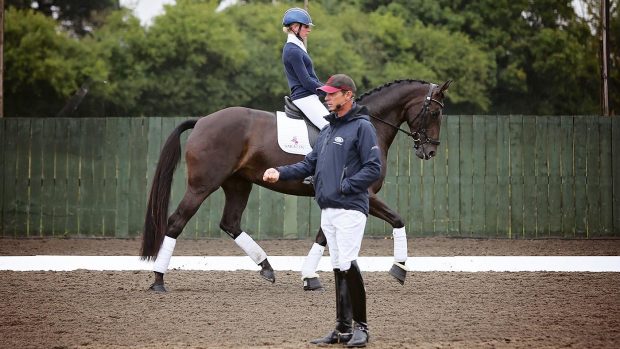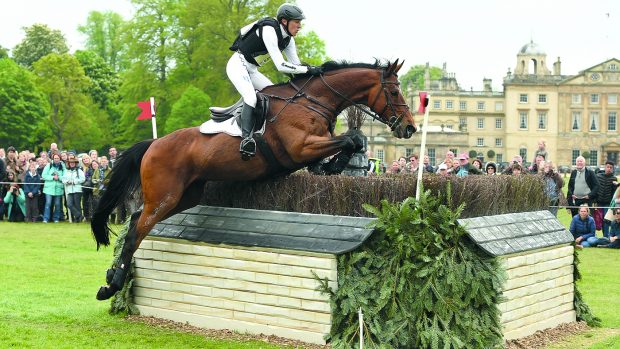US dressage rider, trainer and author Jane Savoie, who passed away in December 2020, explains how to ride the flying change and what skills the horse needs to have established before you to introduce the movement
In order to learn how to ride a flying change, it is important to understand what the movement is. In the flying change the horse remains in canter, but changes the canter lead during the moment of suspension, when all four feet are off the ground. When competing in dressage it is important that changes are made cleanly, with both front and hind legs changing during the same moment of suspension.
A commonly seen mistake is when the horse changes in front in one stride and then behind in the following stride. This is less important when jumping, but the sooner the change is completed, the less balance in the canter will be lost. Cantering disunited to a fence is not giving the horse the best possible chance of cleaning that obstacle without incurring faults.
Preparing for flying changes
Before trying to teach a flying change the horse must be able to:
- Produce a good simple change of lead (canter/walk/canter). The downward transition should be a clear transition to the walk, with no dribbly trot steps. Shorten the canter with collecting half halts before you ask for the transition. If the horse is travelling too fast he will lose his balance on to the forehand in the downward transition. The upwards transition should be quick off the leg without being rushed or explosive.
- Be balanced in counter canter. Develop the counter canter until the horse can comfortably maintain it without tension on circles and lines. To test the horse’s balance ensure you can extend and collect in the counter canter without the horse switching leads.
- Be comfortable in collected canter. As the flying change is another canter stride the quality of the canter is vital to its success. The canter should have big, round, expressive, “off the ground” strides. Any tendency towards a canter that is four-time or flat will not give the horse time to change his legs in the air. Develop and maintain the quality of the collected canter by working on exercises that increase collection such as shoulder-in, travers, frequent simple changes of lead (five strides of walk and five strides of canter), and collecting half halts.
Understanding the collecting half halt
During a collecting half halt the rider should close their legs, push with their seat and close their outside hand for a moment. This engages the horse’s hind quarters and encourages them to wait and “sit” on their hocks.
Ride three collecting half halts in the canter, while thinking about reducing the amount of ground your horse covers with each stride by about 50% but maintain the same rhythm and tempo. During the short, engaged strides, pick a spot on the ground and imagine that you’re cantering on top of it for three strides. Then, go forward for several strides, and ask him to collect again for three strides.
How to ride a flying change
The timing of the aids is very important in riding a successful flying change. Give the aids as the horse’s leading front leg is coming forward. You need to give the aid before the period of suspension because it takes your horse a moment to ‘hear’ your request and another moment to carry it out.
You can practice the correct timing of the aids in the walk and then the canter by watching when the horse’s inside front leg comes forward. Each time you see it coming forward, say out loud, “Now, now, now”. In this way, you learn to coordinate your voice with the inside front leg coming forward.
For a flying change from left to right:
- Seat: Push your right seat bone forward toward your horse’s right ear.
- Right leg: Close your right leg on the girth to ask your horse to go forward during the change.
- Left leg: Swing your left leg behind the girth to signal the new outside hind leg to strike off into the new lead. (Don’t hold this leg back. Pretend your leg is spring-loaded so you give a quick aid.)
- Left rein: Close your left hand in a fist to keep the left hind leg on the ground and maintain uphill balance. Imagine that you’re closing and opening your hand so fast that you can snatch a fly out of the air.
- Right rein: Soften your right rein so you don’t block the new inside front leg from coming forward.
I like to introduce flying changes on a 10-meter figure of eight. Ride simple changes of lead in the centre of the figure of eight. Repeat until the horse understands and anticipates that he’s going to change leads. When you feel him anticipating, give the aids for the flying change instead of doing the simple change. If he changes, praise him a lot. If he doesn’t then stay calm and repeat the process.
Now you know how to perfect your flying changes, why not sign up to Horse & Hound’s eight-week e-training plan to give your training focus and perfect your flatwork basics?


